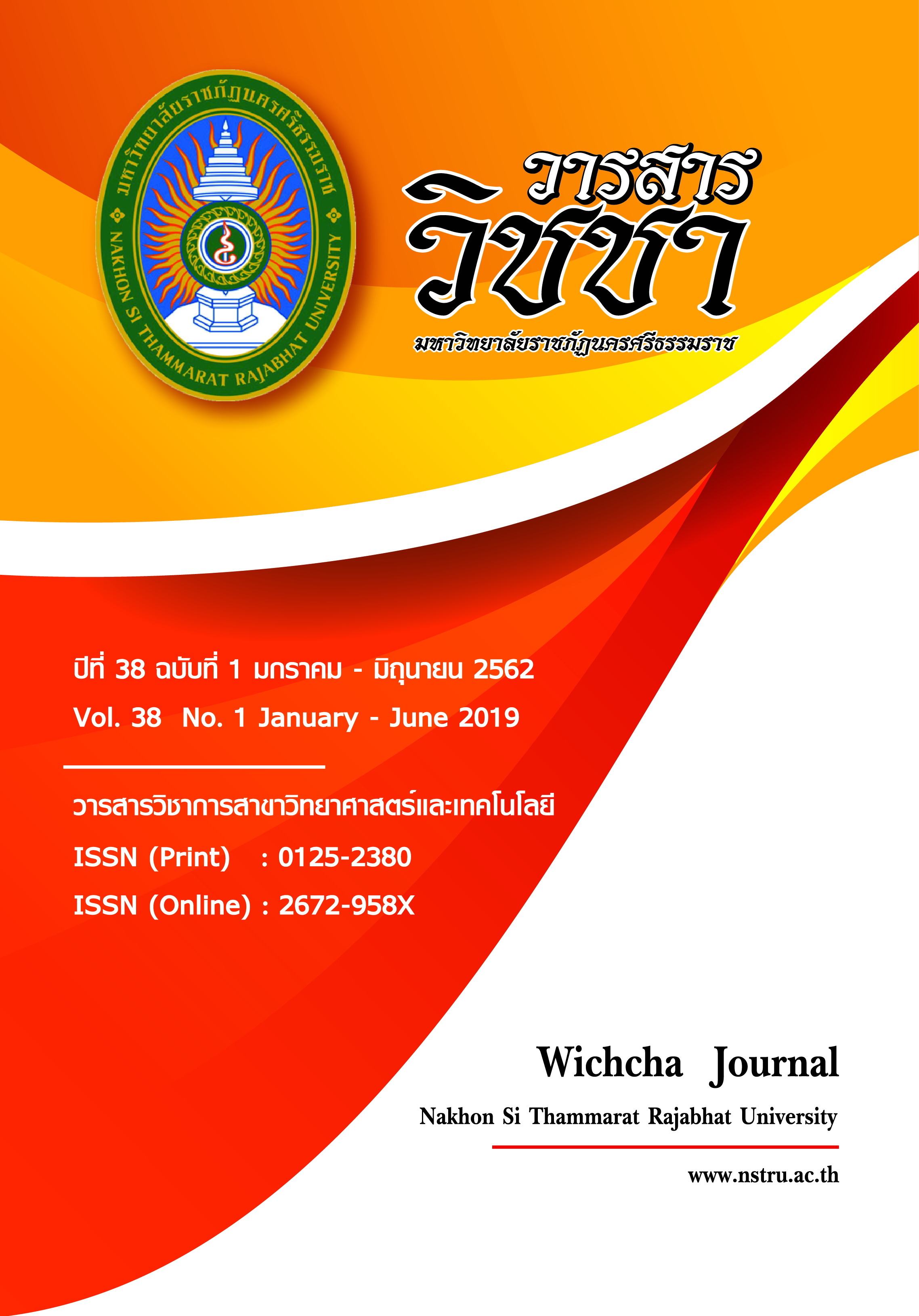Effects of Extraction Solvents and pH on the Amount and Stability of Crude Color Extracted from Plants ผลของตัวทำละลายและความเป็นกรด-ด่าง ต่อปริมาณและความคงตัวของสารสีที่สกัดได้จากพืช
Main Article Content
Abstract
This research aimed to study the effects of solvents on the yields of substances extracted from natural dyes and study the stability of natural dyes at various pHs using 5 species of plants, namely, Siam weed’s leaves, Ironwood’s bark, Broken bones tree’s leaves, Jackfruit’s core, and Mangosteen’s peels. The results showed that polar solvents such as methanol and distilled water were found to be the best to extract plant-based substances such as Siam weed’s leaves and Mangosteen’s peels while non-polar solvents such as hexane were better off extracting substances from Jackfruit’s core. Besides, the study of the stability of natural dyes at various pHs by measuring the maximum absorbance with the UV-Visible spectrophotometer, having their shades compared to Munsel color chart and measuring color values with L*a*b system with the colorimeter found that each dye had different shades and intensity of dyes in various pH ranges. The Siam weed’s leaves dye extracts from all solvents had a tendency to darken the shade in the base condition. Dye extracts from Ironwood’s bark using acetone and methanol solvents were dark colored at pH equal to 12. Dye extracts from broken bones tree’s leaves using dichloromethane, acetone, and methanol as solvents appeared yellow and showed the darkest shade in methanol solvents at pH equal to 12. Similarly, dye extracts from the Mangosteen’s peels in all solvents gave the darkest shade at pH equal to 12. Dye extracts from Jackfruit’s core using acetone, methanol and distilled water as its solvents appeared dark-brown color but were not differ in each pH ranges. This research showed that solvents and pH affected the amount and intensity of natural extracts.
Article Details
เนื้อหาและข้อมูลในบทความที่ลงตีพิมพ์ในวารสารวิชชา มหาวิทยาลัยราชภัฏนครศรีธรรมราช ถือเป็นข้อคิดเห็นและความรับผิดชอบของผู้เขียนบทความโดยตรง ซึ่งกองบรรณาธิการวารสารไม่จำเป็นต้องเห็นด้วยหรือร่วมรับผิดชอบใด ๆ
บทความ ข้อมูล เนื้อหา รูปภาพ ฯลฯ ที่ได้รับการตีพิมพ์ในวารสารวิชชา มหาวิทยาลัยราชภัฏนครศรีธรรมราช ถือเป็นลิขสิทธ์ของวารสารวิชชา มหาวิทยาลัยราชภัฏนครศรีธรรมราช หากบุคคลหรือหน่วยงานใดต้องการนำข้อมูลทั้งหมดหรือส่วนหนึ่งส่วนใดไปเผยแพร่ต่อหรือเพื่อการกระทำการใด ๆ จะต้องได้รับอนุญาตเป็นลายลักษณ์อักษรจากวารสารวิชชา มหาวิทยาลัยราชภัฏนครศรีธรรมราชก่อนเท่านั้น
The content and information in the article published in Wichcha journal Nakhon Si Thammarat Rajabhat University, It is the opinion and responsibility of the author of the article. The editorial journals do not need to agree. Or share any responsibility.
References
ดารณี ขันเพ็ชร และวิรัน วิสุทธิธาดา. (2556). อิทธิพลของสารมอร์แดนท์ต่อสมบัติการย้อมเส้นด้ายฝ้ายด้วยสีธรรมชาติที่สกัดจากใบสัก. วารสารวิชาการและวิจัย มทร.พระนคร, (ฉบับพิเศษ), 357-363.
นันทิพย์ หาสิน และฉัตรดาว ไชยหล่อ. (2559). การศึกษากระบวนการสกัดสีธรรมชาติจากพืช เพื่องานมัดย้อม. ใน การประชุมวิชาการระดับชาติ นอร์ทเทิร์นวิจัย ครั้งที่ 3 (หน้า 513-516). ตาก: วิทยาลัยนอร์ทเทิร์น.
นุชนาถ มีพันธ์ ศศิประภา รัตนดิลก ณ ภูเก็ต และศรันยา คุณะดิลก (2559). การย้อมผ้าไหมด้วยสีย้อมธรรมชาติจากเหง้ากระชายดำ. วารสารคหเศรษฐศาสตร์, 59(2), 26-35.
ปิยะธิดา สีหะวัฒนกุล และอนุสรณ์ ใจทน. (2556). การศึกษากระบวนการย้อมสีใบตองแห้งด้วยสีธรรมชาติและสีวิทยาศาสตร์เพื่องานศิลปะประดิษฐ์. กรุงเทพฯ: คณะเทคโนโลยีคหกรรมศาสตร์ มหาวิทยาลัยเทคโนโลยีราชมงคลพระนคร.
พรพิมล ม่วงไทย สุจิตรา ศรีสังข์ นงนุช พรมรงศ์ และชุติมาพร วรรณวงษ์. (2553). การเตรียมผงสีย้อมจากเปลือกมังคุดบนสารดูดซับ. การประชุมวิชาการ มหาวิทยาลัยเกษตรศาสตร์ วิทยาเขตกำแพงแสน ครั้งที่ 7 (หน้า 1975-1984). นครปฐม: มหาวิทยาลัยเกษตรศาสตร์ วิทยาเขตกำแพงแสน
ระมัด โชชัย. (2556). การย้อมสีเส้นด้ายฝ้ายด้วยสีย้อมธรรมชาติจากใบและเปลือกต้นมะม่วงสำหรับอุตสาหกรรมครอบครัว. วารสารวิจัยเพื่อการพัฒนาเชิงพื้นที่, 5(4), 116-127.
วีรนุช วอนเก่าน้อย พันธิวา แก้วมาตย์ อลงกลด แทนออมทอง และพรณรงค์ สิริปิยะสิงห์ (2558). การคัดเลือกสารสีสกัดจากธรรมชาติในเขตภาคตะวันออกเฉียงเหนือของประเทศไทยเพื่อใช้เป็นสีย้อมโครโมโซม. วารสารวิจัยเพื่อพัฒนาสังคมและชุมชน มหาวิทยาลัยราชภัฏมหาสารคาม, 2(1), 42-52.
สุดกมล ลาโสภา และรุ่งนภา พิมเสน. (2559). การสังเคราะห์อนุภาคนาโนซิงค์ออกไซด์โดยวิธีเคมีสีเขียวสำหรับปรังปรุงการย้อมสีผ้าฝ้ายด้วยสีธรรมชาติ. วารสารวิชชา มหาวิทยาลัยราชภัฏนครศรีธรรมราช, 35(2), 83-93.
สุมนต์ทิพย์ คงตัน จันทร์ฟัก. (2553). การพัฒนาสีย้อมผมจากพืชสมุนไพรไทย. วารสารวิทยาศาสตร์เกษตร, 41(3), 425-428.
เสาวณีย์ รัตนพานี วิจิตร รัตนพานี และมาลี ตั้งสถิตย์กุลชัย . (2550). รายงานวิจัยการสกัดและการเกิดสารเชิงซ้อนของสีย้อมธรรมชาติจากแก่นฝาง. นครราชสีมา: คลังปัญญา มหาวิทยาลัยเทคโนโลยีสุรนารี.
อนงค์พรรณ หัตถมาศ และสุวภางค์ ศรีเทพ. (2555). การพัฒนาผลิตภัณฑ์จากฝ้ายย้อมสีจากมะขามหวาน. ราชภัฏเพชรบูรณ์สาร, 14(2), 113-119.
อรนุช นาคชาติ ธีระพงษ์ แกมแก้ว รัตนา แสนแสง นวรัตน์ พัวพันธ์ และศิริกุล อัมพะวะสิริ (2560) การย้อมสีไหมด้วยเมล็ดมะขามและเปลือกหุ้มเมล็ดมะขามเพื่อเพิ่มมูลค่าเชิงพาณิชย์. วารสารวิชาการเทคโนโลยีอุตสาหกรรม : มหาวิทยาลัยราชภัฏสวนสุนันทา, 5(2), 59-70.
Agaba, T.A. and Fawole, B. (2016). Phytochemical constituents of siam weed (Chromolaena odorata) and african custard apple (Annona senegalensis). International Journal of Food, Agriculture and Veterinary Sciences, 6(1), 35-42.
Aher, A.N., Pal, S.C., Yadav, S.K., Patil, U.K. and Bhattacharya, S. (2009). Antioxidant activity of isolated phytoconstituents from Casuarina equisetifolia Frost (Casuarinaceae). Journal of Plant Sciences, 4(1), 15-20.
Al-Snafi, A.E. (2015). The Pharmacological importance of Casuarina Equisetifolia -An Overview. International Journal of Pharmacological Screening Methods, 5(1), 4-9.
Buranrat, B., Noiwetch, S., Suksar, T., Ta-Ut, A. and Boontha, S. (2018). Cytotoxic and antimigration effects of different parts of Oroxylum Indicum extract on human breast cancer MCF-7 cells. Science & Technology Asia, 23(4), 42-52.

